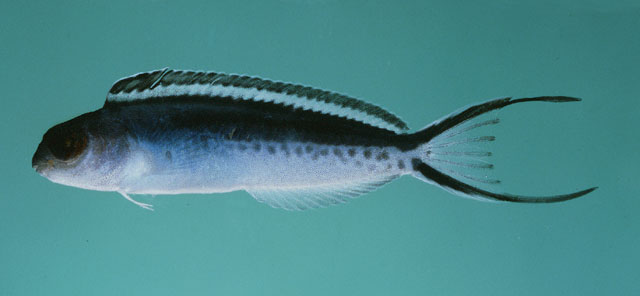| Blenniidae (Combtooth blennies), subfamily: Blenniinae |
| 7 cm SL (male/unsexed) |
|
reef-associated; marine; depth range 0 - 16 m |
| Pacific Ocean: apparently endemic to Tonga. |
|
Dorsal spines (total): 4-5; Dorsal soft rays (total): 25-26; Anal spines: 2-2; Anal soft rays: 15-16. Lunate caudal fin with elongated lobes in both sexes; upper half of body bluish black and lower half abruptly bluish white, posteriorly with few small black spots; dorsal fin basal half black with pale blue stripe composed of 1 spot per membrane broadly joined to the next ; outer half of fin bluish gray with pale thin blue margin and black submarginal line; caudal fin base and lobes black with pale blue upper and lower margins, centroposterior part of fin transparent with dusky rays; pectoral-fin axil without dark spot. Dorsal rays IV-V (rarely IV), 25-26; pectoral soft rays rarely 13; segmented caudal rays 11-12 (typically 11); lateral line present (Ref. 54980). |
| Oviparous. Eggs are demersal and adhesive (Ref. 205), and are attached to the substrate via a filamentous, adhesive pad or pedestal (Ref. 94114). Larvae are planktonic, often found in shallow, coastal waters (Ref. 94114). |
|
Least Concern (LC); Date assessed: 28 March 2009 Ref. (130435)
|
| harmless |
Source and more info: www.fishbase.org. For personal, classroom, and other internal use only. Not for publication.

